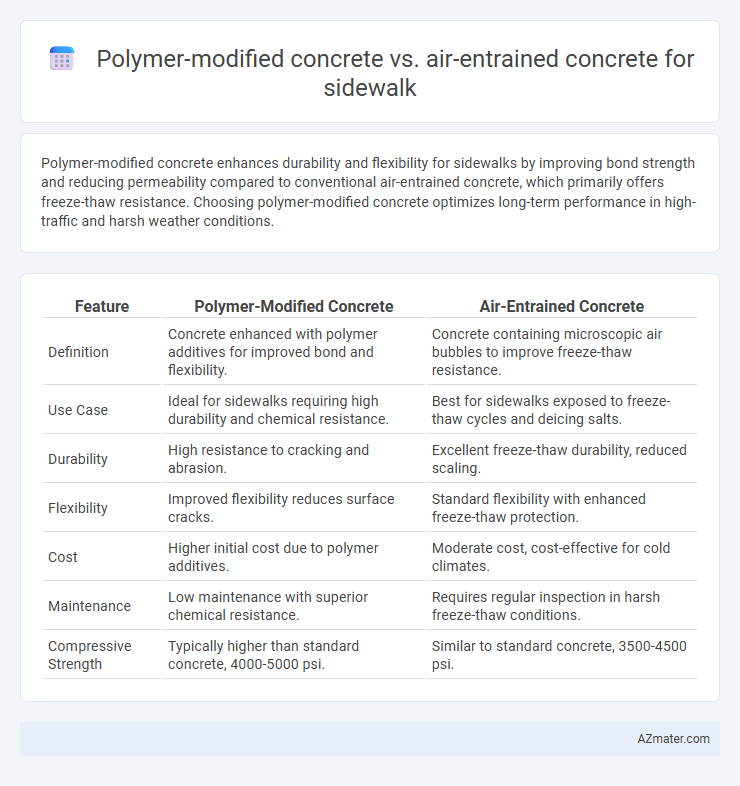Polymer-modified concrete enhances durability and flexibility for sidewalks by improving bond strength and reducing permeability compared to conventional air-entrained concrete, which primarily offers freeze-thaw resistance. Choosing polymer-modified concrete optimizes long-term performance in high-traffic and harsh weather conditions.
Table of Comparison
| Feature | Polymer-Modified Concrete | Air-Entrained Concrete |
|---|---|---|
| Definition | Concrete enhanced with polymer additives for improved bond and flexibility. | Concrete containing microscopic air bubbles to improve freeze-thaw resistance. |
| Use Case | Ideal for sidewalks requiring high durability and chemical resistance. | Best for sidewalks exposed to freeze-thaw cycles and deicing salts. |
| Durability | High resistance to cracking and abrasion. | Excellent freeze-thaw durability, reduced scaling. |
| Flexibility | Improved flexibility reduces surface cracks. | Standard flexibility with enhanced freeze-thaw protection. |
| Cost | Higher initial cost due to polymer additives. | Moderate cost, cost-effective for cold climates. |
| Maintenance | Low maintenance with superior chemical resistance. | Requires regular inspection in harsh freeze-thaw conditions. |
| Compressive Strength | Typically higher than standard concrete, 4000-5000 psi. | Similar to standard concrete, 3500-4500 psi. |
Introduction to Sidewalk Durability Challenges
Polymer-modified concrete enhances sidewalk durability by improving resistance to water penetration, freeze-thaw cycles, and chemical attacks, reducing surface cracking and scaling. Air-entrained concrete introduces microscopic air bubbles that effectively mitigate freeze-thaw damage by relieving internal pressure from expanding water. Both materials address critical durability challenges, but polymer modification offers superior adhesion and flexibility, while air entrainment specifically targets freeze-thaw resistance in cold climates.
Overview of Polymer-Modified Concrete
Polymer-modified concrete incorporates polymers such as latex or acrylics to enhance strength, durability, and adhesion, making it ideal for sidewalks exposed to heavy use and harsh weather conditions. This concrete type improves resistance to cracking, abrasion, and chemical attacks compared to conventional mixes, ensuring longer-lasting pavement performance. Commonly used polymers include styrene-butadiene rubber (SBR) and vinyl acetate ethylene (VAE), which contribute to enhanced flexibility and water resistance in sidewalk applications.
Understanding Air-Entrained Concrete
Air-entrained concrete incorporates microscopic air bubbles that enhance freeze-thaw durability, making it ideal for sidewalks exposed to harsh weather conditions. These air voids improve resistance to scaling and cracking by relieving internal pressure from ice formation. Polymer-modified concrete, while offering increased flexibility and bond strength, does not provide the same level of freeze-thaw protection as air-entrained concrete for pedestrian walkways.
Key Properties Comparison
Polymer-modified concrete offers enhanced tensile strength, improved adhesion, and greater resistance to water penetration compared to air-entrained concrete, making it ideal for high-traffic sidewalks exposed to harsh environmental conditions. Air-entrained concrete excels in freeze-thaw durability due to its microscopic air bubbles that reduce internal stress, providing superior resistance to cracking in cold climates. When selecting materials for sidewalks, polymer-modified concrete is preferred for flexibility and chemical resistance, while air-entrained concrete is favored for longevity in freeze-thaw cycles.
Resistance to Freeze-Thaw Cycles
Polymer-modified concrete exhibits enhanced resistance to freeze-thaw cycles due to its improved elasticity and reduced permeability, which prevent micro-cracking and water ingress during freezing conditions. Air-entrained concrete contains microscopic air bubbles that provide space for water expansion when freezing, significantly improving durability in freeze-thaw environments. For sidewalks exposed to harsh weather, polymer-modified concrete offers superior long-term performance by combining structural integrity with better freeze-thaw resistance compared to traditional air-entrained concrete.
Workability and Placement Considerations
Polymer-modified concrete enhances workability with improved adhesion and flexibility, allowing easier placement in sidewalk applications compared to air-entrained concrete. Air-entrained concrete, designed primarily to improve freeze-thaw resistance, may exhibit reduced slump and require more effort for smooth finishing during placement. Optimal sidewalk performance is achieved by selecting polymer-modified concrete when superior workability and ease of placement are critical under varied environmental conditions.
Cost Analysis of Materials and Installation
Polymer-modified concrete for sidewalks typically incurs higher initial material costs due to expensive polymer additives, which enhance durability and flexibility, reducing long-term maintenance expenses. Air-entrained concrete offers a more cost-effective option with lower material prices and simpler installation processes, providing improved freeze-thaw resistance at a reduced upfront investment. Installation labor costs for polymer-modified concrete may be higher due to specialized handling requirements, while air-entrained concrete benefits from standard placement techniques and faster curing times, decreasing overall project costs.
Maintenance and Lifespan Expectations
Polymer-modified concrete enhances durability and reduces permeability, significantly lowering maintenance needs for sidewalks exposed to freeze-thaw cycles, chemicals, and heavy traffic. Air-entrained concrete offers superior freeze-thaw resistance by incorporating microscopic air bubbles, extending lifespan in cold climates but may require periodic surface repairs due to surface scaling. Lifespan expectations for polymer-modified concrete typically range from 40 to 60 years with minimal upkeep, whereas air-entrained concrete lifespan averages 30 to 50 years, contingent on environmental exposure and maintenance practices.
Environmental Impact and Sustainability
Polymer-modified concrete enhances durability and reduces permeability, leading to longer sidewalk lifespan and less frequent repairs, which minimizes resource consumption and environmental disturbance. Air-entrained concrete improves freeze-thaw resistance and durability in cold climates, reducing maintenance needs but typically has a higher carbon footprint due to added air-entrainment agents and cement content. Selecting polymer-modified concrete for sidewalks supports sustainability efforts through extended service life and lower lifecycle emissions compared to air-entrained concrete.
Best Applications for Each Concrete Type
Polymer-modified concrete is ideal for sidewalks requiring enhanced durability, chemical resistance, and flexibility, particularly in areas exposed to heavy traffic or freeze-thaw cycles. Air-entrained concrete is best suited for sidewalks in cold climates where freeze-thaw resistance and reduced scaling from de-icing salts are critical. Choosing polymer-modified concrete enhances structural integrity under mechanical stress, while air-entrained concrete improves longevity by minimizing internal frost damage.

Infographic: Polymer-modified concrete vs Air-entrained concrete for Sidewalk
 azmater.com
azmater.com